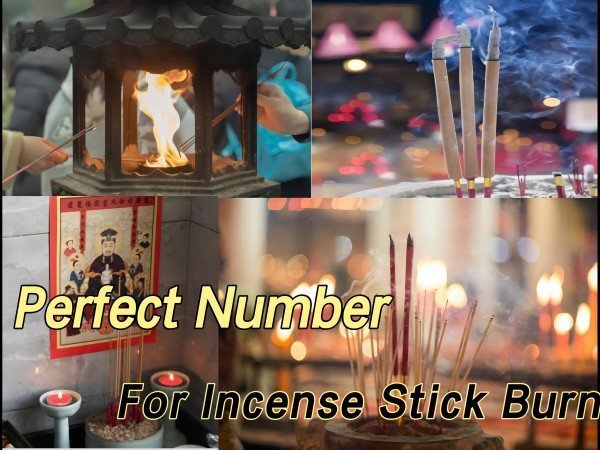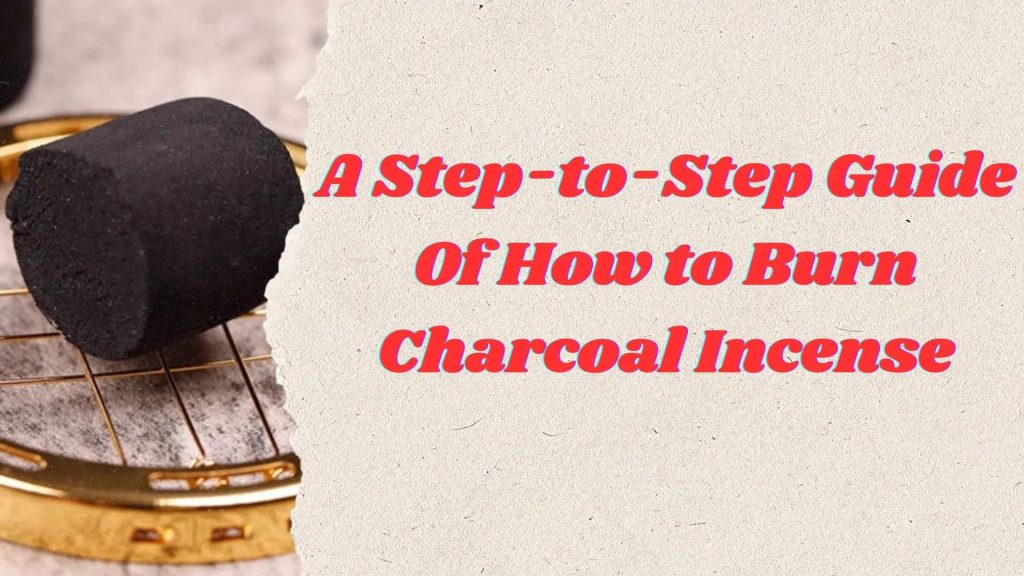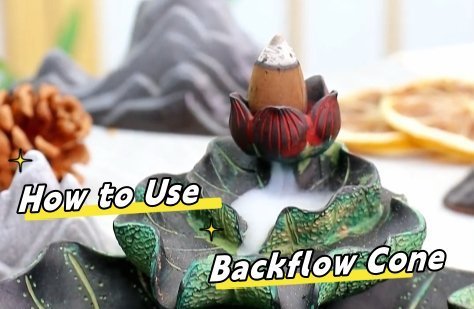Introduction
Incense is widely used for its calming properties, in meditation, and as part of cultural traditions like Taoism and Buddhism. The guide explores the factors that influence how many sticks to burn, such as the size of the space, the intention behind burning, and religious or cultural customs. By following this guide, readers can determine the optimal number of incense sticks to burn, whether for relaxation, cleansing, honoring ancestors, or making spiritual offerings. This article will guide many incense sticks to burn for various purposes, whether for daily use, spiritual practices, or rituals as well as the spiritual meanings of burning incenses.
What Does Incense Do Spiritually? 6 Spiritual Benefits of Burning Incenses
Tailor your incense use to specific intentions like cleansing, attracting love, abundance, or good luck, and setting the perfect mood. From purifying your space to manifesting desires, discover how different scents and the number of incense sticks can transform your environment and energy. Explore how incense can align your space with positivity and purpose.
1. Cleansing and Purification
Incense has long been used across cultures to cleanse and purify a space. Scents like white sage incense and sandalwood incense are especially known for their ability to clear negative energy and refresh the environment. Sandalwood, on the other hand, is often used in meditation and spiritual practices for its grounding properties, bringing clarity and a sense of peace.
2. Attracting Love
Incense can also be used to enhance love and emotional warmth, whether in the context of romantic love or self-love. Scents like rose, jasmine, and sandalwood are particularly effective for fostering romantic feelings or boosting self-esteem. Rose is traditionally associated with deep love, passion, and emotional connections, making it ideal for those looking to enhance their romantic relationships or attract new love.
3. Attracting Money and Abundance
For those seeking to attract wealth and abundance, certain incense scents are believed to align your space and energy with prosperity. Cinnamon and patchouli are the most popular choices for drawing in financial luck and creating a sense of abundance. Patchouli has an earthy, grounding scent that is said to stabilize financial energy and bring in long-term wealth.
4. Attracting Good Luck
Good luck is another area where incense can play a role, with specific scents like frankincense and lemongrass thought to invite good fortune and protect against misfortune. Burning one stick of frankincense or lemongrass is often enough to attract good luck. This is especially useful before starting a new venture, traveling, or making important decisions.
5. Setting a Specific Mood:
Incense is highly effective in setting specific moods and creating the right ambiance depending on the occasion or need. Whether you are looking to relax, meditate, focus, or energize yourself, there are scents that cater to these moods. For relaxation, lavender, chamomile, and sandalwood are excellent choices, helping to calm the mind and body, making them ideal for unwinding after a stressful day.
How Many to Burn At Once
For daily use, the ideal number of incense sticks depends on the size of your space and the strength of fragrance you desire. Typically, burning 1-2 incense sticks is enough to create a calming, aromatic atmosphere that uplifts your mood without being too overpowering.
Room Size and Ventilation
The size of your room plays a crucial role in determining how many incense sticks to burn daily. In small, enclosed spaces (like bathrooms or compact bedrooms), even one stick may fill the room with fragrance. In larger spaces, multiple sticks may be needed to achieve the same effect. For best results, consider placing the incense near airflow points like windows or fans to help spread the fragrance evenly throughout the room, ensuring that the scent remains light and pleasant.
Scent Strength Preferences
Personal preference also comes into play. If you prefer lighter fragrances, stick to burning one incense stick, especially if you’re using strong scents like sandalwood or patchouli. For those who enjoy bold aromas, lighting two incense sticks can intensify the scent and create a more immersive atmosphere. However, be cautious with heavily scented sticks or in small rooms where the scent can quickly become overpowering.
Why Does the Number of Incense Sticks Matter
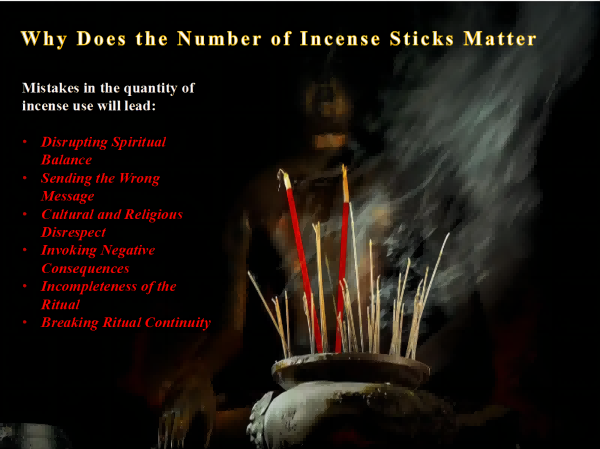
The number of incense sticks used in rituals, especially when honoring ancestors or performing sacred ceremonies, is of immense significance. Each number carries symbolic meaning, representing harmony, balance, or alignment with spiritual forces. Mistakes in the quantity of incense burned can lead to several unintended consequences, both spiritually and culturally.
Reason 1: Disrupting Spiritual Balance
In many traditions, burning the correct number of incense sticks ensures a balance between heaven, earth, and humanity. This balance is crucial to creating harmony and channeling positive energy. Using the wrong number of incense sticks can disrupt this balance, potentially weakening the spiritual connection and the efficacy of the ritual. Instead of fostering peace, the ritual may feel incomplete or unfulfilled, which could lead to spiritual disharmony.
Reason 2: Sending the Wrong Message
Each number of incense sticks carries a specific meaning in cultural and religious contexts. For instance, in Taoism and Buddhism, burning three sticks represents harmony and connection with the spiritual realm. Burning two sticks, on the other hand, is rarely used, as it symbolizes division or death. Making a mistake in the number could unintentionally send the wrong message to the ancestors or deities, leading to a misalignment with the intention of the ritual.
Reason 3: Cultural and Religious Disrespect
In many traditions, burning incense is an act of deep respect and reverence. Mistakes in the quantity of incense can be seen as disrespectful to the ancestors or the spiritual realm. In cultures like Chinese, Taoist, and Buddhist, adhering to the correct practices—including the number of incense sticks—is a demonstration of one’s devotion and sincerity. If the wrong number is used, it may be perceived as a lack of reverence or carelessness, which could offend the spiritual forces or ancestors being honored.
Reason 4: Invoking Negative Consequences
In some traditions, using the wrong number of incense sticks could invoke negative energy or unintended consequences. For example, burning even numbers of incense sticks is often associated with death rituals or mourning in many East Asian cultures, and using an even number during ancestral worship or a positive ceremony might accidentally invite negative spiritual energies. This can bring bad luck or disrupt the protective energy you’re seeking to cultivate.
Reason 5: Incompleteness of the Ritual
Using the incorrect number of incense sticks can make the ritual incomplete. For example, if the tradition calls for three sticks to symbolize heaven, earth, and humanity, but only two are used, the ritual fails to fully acknowledge all realms. This incompleteness might result in missed blessings or ineffective communication with the spiritual world. An incomplete ceremony risks dissatisfaction from the ancestors or deities and could even lead to blocked spiritual guidance.
So How Many Incenses You Should Burn? The Secrets of Even vs Odd Numbers
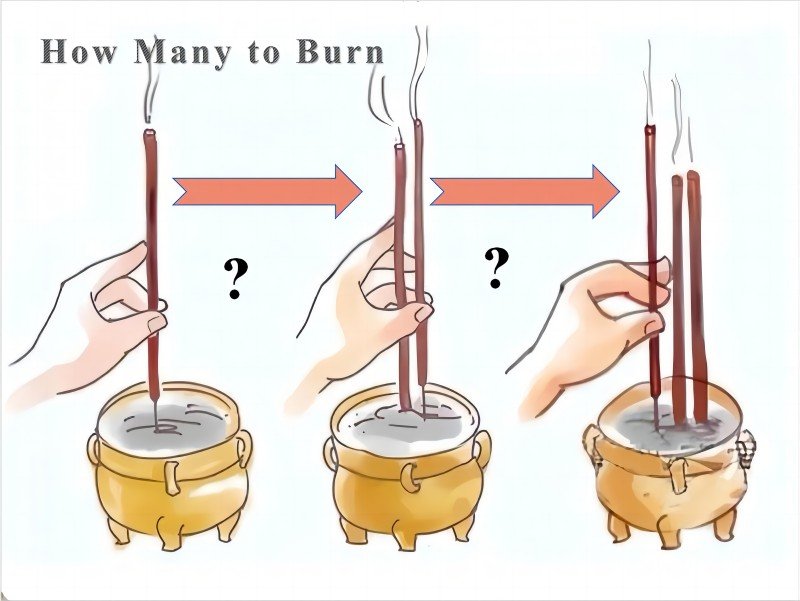
The number of incense sticks burned during spiritual rituals, ceremonies, and daily practices carries significant cultural and symbolic meaning in various traditions, particularly in Feng Shui, Buddhism, and Chinese customs. Understanding the difference between odd and even numbers is essential to ensuring that your practice is aligned with these traditions and their spiritual goals.
Why Odd Numbers Are Preferred?
In Buddhism and Chinese traditions, odd numbers hold special significance because they are seen as representing harmony, balance, and positive energy. These numbers are believed to reflect the flow of yang energy, which is considered active, dynamic, and associated with growth and expansion.
- Symbol of Completeness: In many Eastern spiritual practices, odd numbers are thought to symbolize wholeness and completion. For example, in Taoism’s Feng Shui Theory, burning three sticks of incense is often seen as representing the connection between heaven, earth, and humanity, with the odd number indicating balance between these realms. Similarly, the number five reflects the world’s Five Elements (Wood, Fire, Earth, Metal, and Water), which are integral to maintaining cosmic harmony.
- Positive Energy (Yang):Odd numbers are associated with yang energy, which is considered positive, active, and expansive. In Taoist philosophy, yang represents the active force of the universe—linked to light, heat, and movement. By burning an odd number of incense sticks, you invite this positive, life-affirming energy into your environment, ensuring that the ritual has a harmonious flow and encourages growth and prosperity.
- Fortune and Luck: In many Chinese traditions, odd numbers—like 3, 5, or 7—are considered to be lucky numbers. They symbolize growth, forward movement, and the ability to overcome challenges. Therefore, burning an odd number of incense sticks is thought to attract good fortune, prosperity, and success, making these numbers highly favored in ceremonies like Chinese New Year or temple offerings.
- Spiritual Balance: Odd numbers also symbolize spiritual balance. For instance, burning three sticks creates an offering that includes all aspects of existence: the divine (heaven), the physical (earth), and the human (humanity). This holistic approach ensures that no element is left out, providing spiritual harmony between the realms and ensuring that the ritual is complete.
Why Even Numbers Are Often Avoided?
In contrast to odd numbers, even numbers are frequently seen as inauspicious and are often avoided in spiritual practices. Even numbers, especially the number two, can symbolize duality, incompletion, or even death.
- Incompletion and Imbalance: Even numbers are often associated with incompleteness in spiritual contexts. This is because even numbers can imply division rather than unity or wholeness. For example, burning two sticks of incense is considered incomplete compared to the balance that comes from burning three sticks, which represents the harmonious connection between different realms or elements. In Taoist and Buddhist practices, using two incense sticks can create a sense of imbalance and may fail to honor the spiritual entities properly.
- Duality and Separation:The number two is often associated with duality, which in spiritual terms can represent conflict or opposition. For example, yin and yang in Taoism represent opposites (dark vs. light, passive vs. active), and burning two incense sticks could inadvertently invoke the negative or passive yin energy. This energy is linked to darkness, coldness, and inaction, which are not desirable for most rituals. Therefore, using even numbers can result in misalignment with the desired flow of positive energy.
- Symbol of Mourning and Death: In Chinese funeral customs, two incense sticks are burned to honor the deceased, and this practice is closely tied to mourning and death. As such, using two sticks outside of funeral contexts can be seen as unlucky or disrespectful, as it may unintentionally invoke the spirit of death. This is why even numbers are generally avoidedfor rituals focused on life, prosperity, or blessings.
- Unlucky Connotations: In Chinese numerology, some even numbers are considered unlucky. For example, the number four sounds similar to the word for deathin Chinese (both pronounced “si” in Mandarin), making it especially undesirable in rituals. Burning four incense sticks could therefore carry an unintended connotation of death, further reinforcing the avoidance of even numbers in spiritual practices.
Specific Guidelines of How Many Incense Sticks to Burn
When burning incense for daily use with specific intentions like attracting love, money, good luck, or setting a specific mood, the number of sticks to burn, the type of incense, and the timing all play a crucial role.
Attracting Love
- How Many to Burn: One stick of incense is usually sufficient when you’re aiming to attract love, enhance romance, or promote self-love.
- Why Burn This Number: Burning a single stick helps to create a focused and intimate atmosphere without overwhelming the space, making it ideal for building emotional warmth or self-reflection. Love is a personal and subtle energy, so one stick provides just the right amount of scent and ambiance.
- What Special Incense to Use: Scents like rose, jasmine, or sandalwoodare perfect for love. Rose promotes passion and romantic connections, jasmine enhances emotional healing and intimacy, and sandalwood is often used for self-love and emotional balance.
- When to Light: The best time to burn incense for love is during evening hours, particularly before a date, during a romantic evening at home, or during self-care routines like meditation or a bath.
Attracting Money and Abundance
- How Many to Burn: For attracting wealth and abundance, burning 1or 3 sticks is ideal, depending on the size of the space and the intensity of the ritual.
- Why Burn This Number: One stick is enough for a daily intention or subtle money attraction, while burning three sticks can amplify the energy when you’re actively working on a business project or financial goal.
- What Special Incense To Use: Scents like cinnamon, patchouli, or sandalwood are associated with wealth and prosperity. Cinnamon is known to attract financial success and fast results, patchouli has earthy undertones that ground and stabilize financial energy, and sandalwood helps to manifest long-term abundance.
- When to Light: The best time to burn incense for wealth is in the morning, as it sets the tone for the day’s productivity and financial growth. Burning incense at the start of a workday or business meeting can also align the energy for prosperity.
Attracting Good Luck
- How Many to Burn: For good luck, burn one stick for daily use or three sticks for special occasions when you need a stronger flow of luck.
- Why Burn This Number: One stick maintains a light, ongoing invitation for luck into your life, while three sticks can intensify the effect for important events such as job interviews, exams, or starting new ventures. The number three is often considered auspicious for attracting luck and favor from the universe.
- What Special Incense To Burn: Incense like frankincense, lemongrass, or sandalwood are ideal for good luck. Frankincense is used for clearing away bad energy and bringing in new opportunities, lemongrass is known for its refreshing energy that removes obstacles, and sandalwood is great for overall positivity.
- When to Light: Incense for good luck can be burned on Monday mornings to start the week positively, or before any significant event or opportunity where luck plays a role.
Setting a Specific Mood
- How Many to Burn: Typically, burning one stickis sufficient for setting a specific mood, whether for relaxation, creativity, or focus. However, in larger spaces, two sticks might help create a stronger presence.
- Why Burn This Number: One stick gently transforms the atmosphere without overpowering the space, creating the desired ambiance whether you’re relaxing, working, or socializing. Two sticks can be used in larger areas to ensure the scent is evenly spread.
- What Special Incense To Burn: The choice of incense depends on the mood:For relaxation, try lavender, sandalwood, or chamomile. For creativity, scents like peppermint, eucalyptus, or citrus are energizing. For focus, rosemary, cedarwood, or sandalwood work well to clear the mind and improve concentration.
- When to Light: Burn incense for setting a mood whenever you need a shift in energy. For relaxation, it’s best to light it in the evening, while for creativity and focus, burning incense in the morning or afternoon aligns with peak energy levels.
How Many Incenses to Burn in Buddhism? Symbolic Meaning of Incense
Why Offer Incense to Buddha?
In Buddhism, burning incense is a deeply symbolic practice representing purification, devotion, and the impermanence of life. Incense is used during meditation, prayer, and rituals to honor the Three Jewels—Buddha, Dharma, and Sangha. The number of sticks burned, the type of incense, and when it is lit all play important roles in enhancing spiritual growth and inner peace.
Here are top three symbolic & spiritual benefits of offering incense to Buddha:
- Purification: Burning incense helps cleanse both the space and the practitioner’s thoughts, making it easier to focus on meditation or prayers. The smoke is believed to carry away negative thoughts and distractions, allowing practitioners to focus on the present moment and the Buddhist teachings.
- Offering and Devotion: In Buddhist practice, incense is offered to the Buddha as a sign of respect and reverence. It is also seen as a way to offer good intentions, creating merit, and inviting positive energies into one’s life.
- Enlightenment: Incense burning represents the path to enlightenment. As incense burns slowly and continuously, it symbolizes the progressive nature of spiritual growth and mindfulness, reminding practitioners to persist in their journey toward nirvana.
How Many Incense Sticks Should You Burn in Buddhism?
- Three incense sticks: In Buddhism, the most common practice is to burn three incense sticks. Each stick has a distinct and profound meaning tied to the Three Jewels:The Buddha; The Dharma; The Sangha. What’s more, the number three is particularly significant in Buddhism because it encapsulates the core pillars of the spiritual path. Burning three incense sticks brings balance and holistic recognition of all the elements needed for enlightenment: personal practice, wise guidance, and communal support.
- Five incense sticks: In some cases, especially during special rituals or important ceremonies, five incensesticks may be burned. The number five has deep symbolic significance in Buddhism, such as Five Ethical Guidelines for lay Buddhists, which include refraining from killing, stealing, sexual misconduct, lying, and intoxication; Five Wisdoms, which is mirror-like wisdom, equality wisdom, discriminating wisdom, all-accomplishing wisdom, and the wisdom of dharmadhatu; Five Aggregates, which represents form, sensation, perception, mental formations, and consciousness.
- One incense stick: For more personal and informal practices, such as daily meditation at home or short prayers, one incense stickmay be burned. Burning just one stick is seen as a minimalistic offering, suitable for shorter meditations or moments of mindfulness where the focus is on the purity of intention rather than elaborate ritual.
Which Incense to Burn in Buddhism?
Here are three main incenses you should choose from:
- Sandalwood: One of the most widely used incense types in Buddhist practice. It has a calming and grounding effect, promoting focus and spiritual clarity. Sandalwood is often burned during meditation and is associated with tranquility and enlightenment. It helps the practitioner focus on spiritual growth and inner peace.
- Aloeswood: Known for its rich, deep aroma,aloeswood is often used during formal ceremonies or important Buddhist rituals. It represents spiritual purification and clarity of mind, helping to remove distractions and impurities from the practitioner’s thoughts.
- Frankincense: This incense is associated with cleansing and purification. It is commonly used in temples or sacred spaces to purify the area and invite positive energy. The scent of frankincense helps practitioners reach a state of spiritual awareness and calmness, making it ideal for meditation and prayer.
When to Burn Incense in Buddhism?
- During Meditation: Burning incense at the start of a meditation session is a common practice in Buddhism. The scent of the incense helps the practitioner enter a calm state of mind, focusing on their breath and thoughts. Sandalwood or frankincense is typically used for its calming and grounding qualities. It helps set the tone for a peaceful and focused meditation session.
- During Prayer or Offerings: Incense is burned during offerings to the Buddha, when praying for blessings, or showing gratitude. This often occurs in temples, but also at home shrines. Special ceremonies, like Vesak (Buddha’s birthday) or New Year celebrations, often include incense offerings for both ancestors and deities.
- At Morning or Evening Rituals: Many Buddhists burn incense during their morning or evening prayers. Burning incense in the morning serves as an offering to start the day with mindfulness and peace, invoking blessings and spiritual clarity throughout the day. Evening rituals may focus on reflection, burning incense to purify the mind and release stress from the day, leading to inner calm before sleep.
- Special Buddhist Ceremonies: Incense is an integral part of larger Buddhist ceremonies, such as monk ordination, funerals, or pilgrimages to temples. For instance, during a funeral, incense is burned to purify the soul of the deceased and guide them on their journey.
How Many Incenses Should Burn in Christian?
In Christianity, the absence of strict rules regarding the number of incense sticks burned reflects the emphasis on spiritual intention and flexibility in worship. The act of burning incense is deeply symbolic, representing prayers, sanctification, and divine presence, but the number of sticks or the amount of incense is left to personal choice, the discretion of the clergy, or the specific context of the service.
Is There Any Rule About How Many Sticks to Burn?
- One stick: In private prayer or meditation at home, burning one stick of incense is often seen as enough to create a sacred atmosphere. This represents the simplicity of one’s prayers rising to God and the desire for spiritual focus.
- Three incense sticks: Some Christians, particularly in Eastern Orthodox and Eastern Catholic traditions, may burn three incense sticks during personal prayers or rituals at home, symbolizing the Holy Trinity—the Father, the Son, and the Holy Spirit. This practice is, however, not universal across all denominations.
Which Incense to Burn?
- Frankincense: Represents purity and holiness, often used in the presence of God.
- Myrrh: Associated with sacrifice and anointing, commonly used during funeral rites and important Christian ceremonies like baptisms.
- Blends: Many church incenses combine these and other spices to create a fragrance suitable for worship.
When to Burn Incense?
- During Church Services: Incense is burned at significant moments, such as during the Mass, funeral rites, and other sacraments. The priest may use the censer to sanctify the altar, the congregation, or the Eucharist.
- At Home: In personal devotion, incense can be burned during times of prayer, reflection, or Bible study. Some people burn incense during morning or evening prayers to create a holy atmosphere and elevate their connection with God.
- Special Occasions: Incense is often burned during important Christian holidays like Easter, Christmas, and Good Friday, representing the sanctification of the space and the holy nature of these celebrations.
For a more detailed illustration, you can read our article What Does the Bible Say about Incense?
How Many Incenses Should Burn in China’s Feng Shui Theory?
What Does Burning Incense Mean in Chinese Culture?
The meaning of burning incense in Chinese culture goes beyond simple tradition; it is an act deeply intertwined with spiritual communication, reverence for ancestors and deities, purification, and the creation of balance in one’s life and surroundings.
- Spiritual Communication and Connection: Burning incense connects the human and spiritual worlds. The rising smoke symbolizes prayers and respect reaching the divine, representing communication with ancestors and deities for guidance and protection.
- Ancestor Worship and Reverence: Incense burning honors deceased family members, maintaining their memory and spiritual care. The smoke carries respect and requests for blessings, symbolizing ongoing communication with ancestors in the afterlife.
- Offering to Deities and Spirits: Incense is offered to deities for blessings like protection, health, and success. Burning it signifies reverence to higher powers, with the smoke representing respect and devotion reaching the gods.
- Purification and Cleansing: Incense purifies spaces, clears negative energy, and wards off evil spirits. The smoke cleanses and sanctifies spaces during rituals, fostering positive Qi and harmonious living for spiritual practices.
How about Incense Sticks Used in Chinese New Year?
During Chinese New Year, burning incense at the family altar or temple helps ensure that the family is blessed with health, wealth, and happiness for the year ahead
How Many Incense Sticks to Burn for Chinese New Year?
- Typically, three or five incense sticksare burned during Chinese New Year celebrations. The act of burning incense symbolizes a new beginning, cleansing the space and inviting good fortune for the family.
- Three sticks are often used to symbolize the harmony between heaven, earth, and humanity.
- Sometimes, five sticks may be burned, representing the Five Elements—Wood, Fire, Earth, Metal, and Water—to maintain balance and harmony in the home throughout the new year.
What Kind Incense to Burn in Chinese New Year?
- Sandalwood: Represents prosperity and good fortune.
- Jasmine or Lotus: Promotes harmony and peace within the family.
- Cedarwood or Pine: Known for their protective properties, they help to ward off bad energy or spirits.
How about Incense Sticks Used for the Dead in Chinese Culture?
During rituals for the dead, such as Qingming Festival or Ghost Month, families burn incense at gravesites or home altars, showing respect and ensuring that their ancestors are at peace.
How Many Incense Sticks to Burn for the Dead in Chinese Culture?
- Burning incense for the dead serves as a way to pay respects, honor ancestors, and ensure their peace in the afterlife. Three incense sticks are burned to honor the dead in Chinese culture. The three sticks commonly symbolize the same harmony as in many Taoist rituals, bringing spiritual comfort to the souls of ancestors.
- However, in certain rituals such as funerals or the Qingming Festival (Tomb-Sweeping Day), one or even seven sticksmight be used. In funeral rituals, one incense stick may be burned as a simple and solemn offering for the departed, symbolizing the direct communication between the living and the deceased. Burning seven sticks may be used for more elaborate ceremonies, symbolizing cosmic order and a more intense reverence.
What Kind of Incense to Burn in Honoring the Dead?
- Sandalwood: A common choice for ancestor worship due to its associations with purity and protection.
- Frankincense or Myrrh: These are often used to purify the space and honor the memory of the deceased.
- Chinese Herbal Incense: Blends containing ingredients like sage or wormwood are often used for their cleansing properties, ensuring the space is cleared of negative energies.
Four Essential Tips for Beginners
For someone new to burning incense, the number of incense sticks to burn plays an important role in rituals, ceremonies, and spiritual practices across various traditions. The number of incense sticks can carry symbolic meaning, influence the atmosphere, and align with cultural or spiritual customs. So what I should know about incense burn numbers.
- Know the Occasion: Always consider the purpose of the ritual or ceremony before deciding how many sticks to burn. Three sticks are typically safe for most situations, representing balance, respect, and completeness.
- Research Cultural Significance: Understand the cultural or spiritual meaning of the numbers in the tradition you’re following. For example, avoid even numbers unless specifically used for mourning or funerals.
- Start with One Stick: If you’re new to burning incense and unsure of what to do, start with one stickfor personal prayers or meditation. It’s a simple and respectful way to focus your intentions without worrying about complex rituals.
- Ask for Guidance: In temples or spiritual communities, don’t hesitate to ask local practitioners about the correct number of incense sticks to burn for specific rituals. They can guide you on the proper etiquette based on their cultural or spiritual beliefs.
For learning about using incense sticks, you can read our article how to burn incense sticks.
Frequently Asked Questions
What Is The Meaning of 1 Incense Sticks?
In Chinese culture, when it comes to 1 incense sticks meaning, burning one incense stick represents:
- Purity: It symbolizes a clean, focused intention, without excess.
- Respect: Used in offerings to ancestors or deities, honoring their presence.
- Spiritual Connection: The smoke links the practitioner to the divine or the ancestors, facilitating communication.
- Simplicity: Reflects the idea of a minimalistic and meaningful gesture, emphasizing intention over quantity
What Is The Meaning of 2 Incense Sticks?
To explain 2 incense sticks meaning, the number 2 symbolizes duality and balance in Chinese culture. It represents the idea of opposites coming together to create harmony, such as yin and yang, heaven and earth, or sun and moon.
Burning 2 incense sticks signifies the desire for balance in one’s life, relationships, and surroundings. It may be used in rituals to invite peace or restore equilibrium between opposing forces.
What Is The Meaning of 3 Incense Sticks?
As for 3 incense sticks meaning, in Chinese Feng Shui, burning 3 incense sticks holds deep symbolic meaning:
Balance of Heaven, Earth, and Humanity: The number three represents harmony between these three realms, aligning spiritual, earthly, and human energies.
Inviting Good Fortune: Three sticks symbolize the invitation of positive energy, prosperity, and protection into one’s home or life.
Purification and Blessings: Burning three sticks helps purify the space, clear negative energy, and attract blessings from both ancestors and deities.
Symbol of Completeness: The number three is considered a powerful, complete number in Chinese culture, representing wholeness and the fulfillment of spiritual intentions.
In Feng Shui, burning three incense sticks creates a balanced and auspicious atmosphere, often for rituals, ceremonies, or blessings in the home
What Is The Meaning of 5 Incense Sticks?
When it comes to 5 incense sticks meaning, the number five represents the Five Elements of Chinese philosophy—Wood, Fire, Earth, Metal, and Water. Burning five sticks of incense is thought to help balance and harmonize these elemental forces in the environment, promoting overall well-being and positive energy (Qi). The five sticks are believed to provide a stronger protective energy, clearing negative forces and stabilizing the space. This is often used in rituals to enhance prosperity, health, and peace
What Is The Meaning of 7 Incense Sticks?
For 7 incense sticks meaning, in Chinese culture, the number 7 is often linked to the spiritual realm and the connection with ancestors. It is believed that burning seven incense sticks can represent an offering to spirits or deities. The 7th month of the lunar calendar is known as the Ghost Month (Hungry Ghost Festival), where people burn incense to honor spirits. In this context, burning seven incense sticks can serve as a ritual to honor ancestors and invoking blessings.
What Is The Meaning of 9 Incense Sticks?
When it comes to 9 incense sticks meaning, the number 9 is considered a symbol of longevity and eternity in Chinese culture. This is because the word for 9 (“九” – jiu) sounds similar to the word for long-lasting or forever (“久” – jiu).
Burning 9 incense sticks can symbolize a wish for long life, good health, and eternal blessings. It’s often used in rituals or ceremonies that focus on well-being and longevity.

